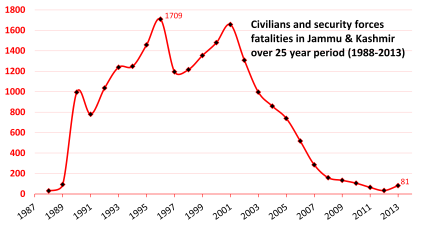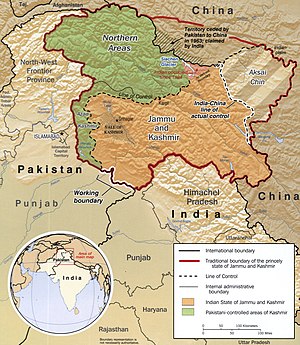Kasmeer news. GeniusJarvis.blogspot.com.

Insurgency in Jammu and Kashmir
The insurgency in Jammu and Kashmir or the Kashmiri Insurgency (also known as Kashmir Intifada)[15][16][17] is a conflict between various Kashmiri separatists[18][19][20][21][22] and the Government of India. There are some groups that support the complete independence of Kashmir, while others seek Kashmir's accession to Pakistan.[23] The conflict in Jammu and Kashmir has strong Islamist elements among the insurgents, with many of the "ultras" identifying with Jihadist movements and supported by such.[24]
The roots of the conflict between the Kashmiri insurgents and the Indian government are tied to a dispute over local autonomy.[25]Democratic development was limited in Kashmir until the late 1970s and by 1988 many of the democratic reforms provided by the Indian government had been reversed and non-violent channels for expressing discontent were limited and caused a dramatic increase in support for insurgents advocating violent secession from India.[25] In 1987, a disputed State election[26] created a catalyst for the insurgency when it resulted in some of the state's legislative assembly members forming armed insurgent groups.[27][28][29] In July 1988, a series of demonstrations, strikes and attacks on the Indian government began the Kashmir insurgency, which during the 1990s escalated into the most important internal security issue in India.
Thousands of people have died[30] during fighting between insurgents and the government as well as thousands of civilians who have died as a result of being targeted by the various armed groups.[31]
The Inter-Services Intelligence of Pakistan has been accused by India of supporting and training mujahideen.[32][33] to fight in Jammu and Kashmir.[3][33][34] In 2015, former President of Pakistan Pervez Musharrafadmitted that Pakistan had supported and trained insurgent groups in the 1990s.[35]According to official figures released in Jammu and Kashmir assembly, there were 3,400 disappearance cases and the conflict has left more than 47,000 people dead which also includes 7,000 police personnel as of July 2009.[36]
However, the number of insurgency-related deaths in the state have fallen sharply since the start of a slow-moving peace processbetween India and Pakistan.[37] Some rights groups claim a higher figure of 100,000 deaths since 1989.[14]
History of the movement
1947–1987
After independence from colonial rule India and Pakistan fought a war over the princely state of Kashmir. At the end of the war India controlled the most valuable parts of Kashmir.[38] While there were sporadic periods of violence there was no organised insurgency movement.[39]
During this period legislative elections in Jammu and Kashmir were first held in 1951 and Sheikh Abdullah’s secular party stood unopposed. He was an instrumental member in the accession of the state to India.[40][41]
However Sheikh Abdullah would fall in and out of favour with the central government and would often be dismissed only to be re-appointed later on.[42] This was a time of political instability & power struggle in Jammu and Kashmir and it went through several periods of President's rule by the Federal Government.[29]
1987–2004

The trend in total yearly civilian and security forces fatalities from insurgency-related violence over 25 years from 1988 to 2013.[43]
After Sheikh Abdullah’s death, his son Farooq Abdullah took over as Chief Minister of Jammu and Kashmir. Farooq Abdullah eventually fell out of favour with the Central Government and the Prime Minister Indira Gandhi had his government toppled with the help of his brother-in-law G. M. Shah. A year later, Abdullah reached an accord with the new Prime Minister Rajiv Gandhi and announced an alliance with the Congress party for the elections of 1987. The elections were allegedly rigged in favour of Abdullah.[27][29]
Most commentators state that this led to the rise of an armed insurgency movement composed, in part, of those who unfairly lost the elections. Pakistan supplied these groups with logistical support, arms, recruits and training.[24][27][29][44][45]
In the second half of 1989 the alleged assassinations of the Indian spies and political collaborators by JKLF (Jammu and Kashmir Liberation Front) was intensified. Over six months more than a hundred officials were killed to paralyse government's administrative and intelligence apparatus. The daughter of then interior affairs minister, Mufti Mohammad Sayeed was kidnapped in December and four terrorists had to be released for her release. This event led to mass celebrations all over the valley. Farooq Abdullah resigned in January after the appointment of Jagmohan Malhotra as the Governor of Jammu and Kashmir. Subsequently, J&K was placed under Governor's Rule under Article 92 of state constitution.[46]
Under JKLF's leadership on January 21–23 large scale protests were organised in valley. As a response to this largely explosive situation paramilitary units of BSF and CRPF were called. These units were used by the government to combat Maoist insurgency and the North-Eastern insurgency. The challenge to them in this situation was not posed by armed insurgents but by the stone pelters. Their inexperience caused at least 50 casualties in Gawkadal massacre. In this incident the underground militant movement was transformed into a mass struggle. To curb the situation AFSPA (Armed Forces Special Powers Act) was imposed on Kashmir in September 1990 to suppress the insurgency by giving armed forces the powers to kill and arrest without warrant to maintain public order. During this time the dominant tactic involved killing of a prominent figure in a public gathering to push forces into action and the public prevented them from capturing these insurgents. This sprouting of sympathisers in Kashmir led to the hard-line approach of Indian army.[47]
With JKLF at forefront large number of militant groups like Allah Tigers, People's League and Hizb-i-Islamia sprung up. Weapons were smuggled on a large scale from Pakistan. In Kashmir JKLF operated under the leadership of Ashfaq Majid Wani, Yasin Bhat, Hamid Shiekh and Javed Mir. To counter this growing pro-Pakistani sentiment in Kashmir, Indian media associated it exclusively with Pakistan.[48]
JKLF used distinctly Islamic themes to mobilise crowds and justify their use of violence. They sought to establish an Islamic democratic state where the rights of minorities would be protected according to Quran and Sunna and economy would be organised on the principles of Islamic socialism.[49]
The Indian army has conducted various operations to control and eliminate insurgency in the region such as Operation Sarp Vinash,[50][51] in which a multi-battalion offensive was launched against terrorists from groups like Lashkar-e-Taiba, Harkat-ul-Jihad-e-Islami, al-Badr and Jaish-e-Mohammad who had been constructing shelters in the Pir Panjal region of Jammu and Kashmir over several years.[52] The subsequent operations led to the death of over 60 terrorists[53] and uncovered the largest network of militant hideouts in the history of insurgency in Jammu and Kashmir covering 100 square kilometers.[54]
Islamisation of Kashmir in early 1989
During the early period of militancy in 1989, multiple militants groups strive to Islamise Kashmiri culture and political setup to create a conducive environment for the merger of Kashmir with Pakistan. Numerous Islamist groups were formed in early 1990 who emerged advocating Nizam-e-Mustafa (Rule of Muhammad) as the objective for their struggle. Militant groups like Hizbul mujahideen and Jamaat-e-Islami asserted that struggle of Kashmir will continue till Islamic Caliphate is achieved in Kashmir.[55]Murder of Kashmiri Hindus, Intellectuals, Liberals and activists were described necessary to get rid of un-Islamic elements. Concurrently all cinema houses, beauty parlours, wine shops, bars, video centres, use of cosmetics and similar things were banned by militant groups. Many militant organisations like Al baqr, People's league, Wahdat-e-Islam and Allah Tigers imposed restrictions like banning cigarettes, restrictions on Kashmiri girls.[56] Apart from militants, Kashmir was witnessing Islamization during 1980's when Abdullah Government changed the names of about 2,500 villages from their native names to new Islamic names. The Sheikh also started delivering communal speeches in mosques similar to his speeches in the 1930s. Additionally, he referred Kashmiri Pandits as “mukhbir” or informers of the Indian government.[57][58]
2004–11
Beginning in 2004 Pakistan began to end its support for insurgents in Kashmir.[59] This happened because terrorist groups linked to Kashmir twice tried to assassinate Pakistani President General Pervez Musharraf.[45] His successor, Asif Ali Zardari has continued the policy, calling insurgents in Kashmir "terrorists".[60] Although it is unclear if Pakistan's intelligence agency, the Inter-Services Intelligence, thought to be the agency aiding and controlling the insurgency[60][61][62] is following Pakistan's commitment to end support for the insurgency in Kashmir.[60]
Despite the change in the nature of the insurgency from a phenomenon supported by external forces to a primarily domestic-driven movement[38][60][63][64][65] the Indian government has continued to send large numbers of troops to the Indian border.[63][65][66]
There have been widespread protests against the Indian army presence in Kashmir.[63]
Once the most formidable face of Kashmir militancy, Hizbul Mujahideen is slowly fading away as its remaining commanders and cadres are being taken out on a regular interval by security forces.[67] Some minor incidents of grenade throwing and sniper firing at security forces notwithstanding, the situation is under control and more or less peaceful. A record number of tourists including Amarnath pilgrims visited Kashmir during 2012. On 3 August 2012, a top Lashkar-e-Taiba militant commander, Abu Hanzulah involved in various attacks on civilians and security forces was killed in an encounter with security forces in a village in Kupwara district of north Kashmir.[68]
2012–present
According to Indian Army data quoted by Reuters, at least 70 young Kashmiris joined the insurgency in the 2014, army records showed, with most joining the banned group Lashkar-e-Taiba, which was accused of carrying out attacks on the Indian city of Mumbai in 2008. Two of the new recruits have doctorates and eight were post graduates, the army data showed.[69] According to BBC, that despite a Pakistani ban on militant activity in Kashmir in 2006, its fighters continue to attempt infiltration into Indian-administered Kashmir. These attempts were curtailed however when people living along the Line of Control which divides Indian and Pakistani Kashmir started to hold public protests against the activities of the insurgent groups.[70]

Comments
Post a Comment
jarvisshukla123@gmail.com